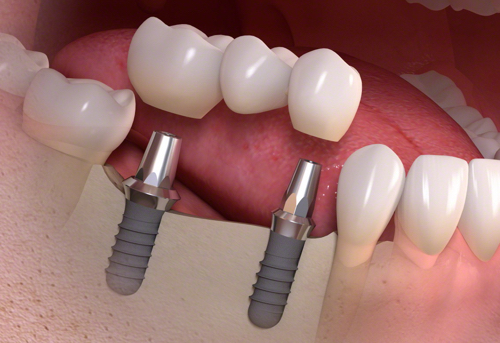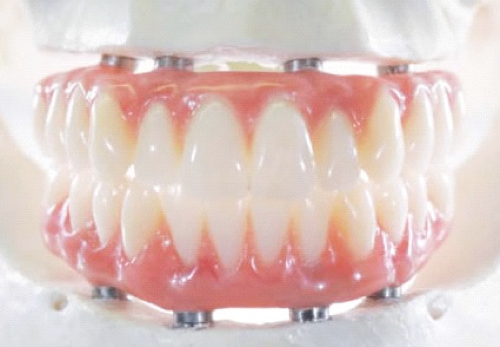Implantology
Artificial Tooth Root
Dental implants are placed in the jaw bone to replace missing natural teeth. One implant can substitute each tooth, but artificial roots are also capable of holding bridges together, or may also be used to anchor removable prostheses. The achievable results depend to a great extent on the initial situation.
If the existing toothlessness comes with a small amount of bone loss, then we can expect a perfect result, or one similar to the original state with only a small cosmetic compromise at the most. If long- standing toothlessness has resulted in severe bone loss, a stable denture is prepared that is aesthetically perfect in areas visible to others but due to its design which aims at making cleaning easier, the neck of the implant near the gums will be recognisable and in some cases hidden by gingival mask (artificial gums).
The lifetime of implants after healing depends primarily on hygienic factors such as the patient's dental hygiene. In all cases it is necessary to use specific tools and water flosser.
The doctor will inform the patient about the results that can be expected after artificial root transplantation, but will also discuss the consequences of not replacing the tooth. You will be informed about all alternative options and their advantages and disadvantages. The written leaflet also includes possible complications of implantation.

Immediate Implantation
In fortunate cases, we can proceed with implantation immediately after the extraction. This minimises the loss of bone during healing, and the patient only has to experience the discomfort of surgery once.
Immediate Burdening
In certain fortunate conditions, the implant can be burdened immediately, meaning the patient can obtain teeth shortly after the operation. The produced temporary prosthesis is almost equivalent to the final in function and aesthetics. This allows the patient to live with a comfortable solution for several months until the implants have healed completely. During this period us professionals too can gain much experience in the development of the final prosthesis that is made to be worn for decades.
Temporary Implantation
In the case of implantation or bone grafting, there may be no teeth of your own or implants available to attach the temporary dental replacement to. In such cases, temporary implants are placed on parts of the jaw bone, where the permanent replacement will not be affected, with the aim of helping keep the temporary tooth replacement in place. These implants are usually removed at the end of the healing period. A temporary implant may also be put in place if it is necessary for 3D computerised implant design or orthodontic treatment.
Replacement of an Individual Tooth - Implant Anchored Crown
The best way to replace a missing tooth in well preserved bone structure is to embed an artificial root (implant). Implants are particularly beneficial if the adjacent teeth are fully or nearly intact.
The traditional bridge is an alternative, but the preservation of healthy teeth is of irrefutable value both cosmetically and functionally. The prosthesis leaning on the implant can be equivalent to a natural tooth both in terms of appearance and the ability to chew. In the front region, where the aesthetic expectations are the highest, both the structure of the implant and the crown can be made of metal-free material (zirconium).
Implant anchored teeth can be attached by adhesives or screws. The advantage of the latter is that the structure can be removed without damage.
Replacement of Several Teeth - Implant Anchored Bridge
In cases of missing teeth, there is no need to replace each with an implant. In general, we can say that every second implant placed can carry the dental structure properly. However, there are no barriers to replace each teeth with implants.
Replacement of All Teeth - Implant-Supported Bridges
If there is no way to retain more than two teeth in a mandible, but the bone conditions are favourable, in most cases we choose only implantation solutions, as they are more reliable and predictable in the long term. If the jaw bone is in good condition after tooth loss, it is possible to fix a bridge to the implants replacing the teeth.
All -on - 4, All - on - 6
This is a popular procedure recently developed for cases of complete toothlessness. Its particular advantage is that it allows fixed replacements to be created by embedding fewer implants of larger surface. In certain advantageous situations it is possible to instantly create fixed tooth replacements, and the end result can be impressive. However, it is important to mention that this type of solution is not feasible in all cases. It is also worth noting that the cleaning of prostheses requires special care, some degree of skill and regular professional hygiene treatment.
The number of implants depend on the size of the implant to be embedded and the quality of the jaw bone. In general, we are able to create a fixed replacement by embedding six implants in the upper jaw and four in the lower jaw. In order to achieve proper support, it is often necessary to adjust the axis of the implants, thus placing them in an unusual angle.
This type of replacement will not only replace the missing teeth but also the hard and soft tissue (gums) surrounding the lost roots.
Since it is fixed in a form that is easily handled by the dentist (with a screw), it gives possibility to maintain its hygiene by a professional cleaning at specific intervals in our dental office.
Another advantage is that the denture can be mended and improved easily when attached with screws.

Overdenture
The most popular version of implants as these can be made for practically everyone.
The greatest advantage of an overdenture is that functionally and aesthetically the same result can be achieved as with fixed replacements, but without the inconvenience of wearing those. In this case, there is no need for a large amount of bone supplement, the aesthetic support of the lips can be easily achieved because the position of the implants can be independent of the aesthetic zone. An overdenture is extremely easy to clean, therefore inflammatory complications around implants are rare and treatable, and any repair can be done effortlessly and cost-effectively without the replacement of the metal parts. This is the most efficient way to restore the unfavourable aesthetic of the face in elderly people, for example, the bite height.
Please click here for more videos on implants.